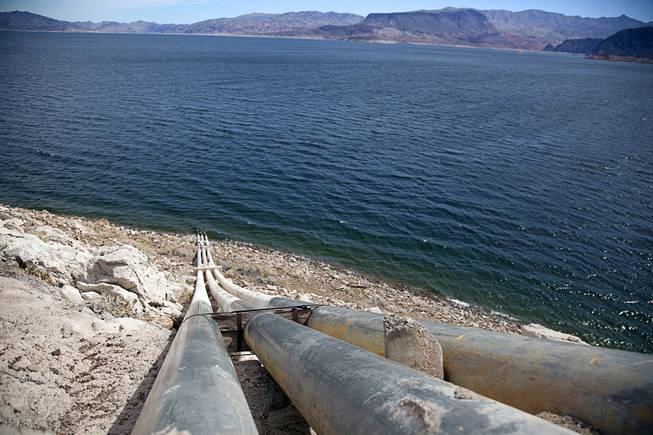
Julie Jacobson / AP
This March 23, 2012, file photo shows pipes extending into Lake Mead well above the high water mark near Boulder City.
Tuesday, Aug. 1, 2017 | 2 a.m.
Related news
In 1989, when Clark County's population was about 700,000, the Las Vegas Valley Water District faced the possibility of a water shortage going into the 21st century. The water district, a predecessor to the Southern Nevada Water Authority, proposed a multibillion-dollar pipeline to convey billions of gallons of groundwater from rural counties northeast of Las Vegas.
Nearly three decades later, plans to build the pipeline have stalled, as the water authority awaits decisions expected this year from a federal judge and the state engineer, Nevada's chief water regulator. The delay is the result of a multipronged legal challenge from environmentalists, ranchers, farmers, local governments and tribes that have argued the drawdown would irreparably harm rural communities, wetlands and pastures in eastern Nevada. At issue are questions of how pumping would impact the environment, given uncertainties in forecasting groundwater recharge.
The coalition, organized as the Great Basin Water Network, argued in court on Monday that the Bureau of Land Management had improperly approved a right-of-way for 250 miles of pipeline that would run over its land.
Lawyers said the agency took a piecemeal approach and failed to consider several variables, including the location of groundwater wells, pumping facilities and climate change.
A BLM lawyer said that the analysis was appropriate for a project of this scale and that there'd be future environmental impact reports. He noted that this land-use application was somewhat unique because federal law directs the BLM to grant rights-of-way to the SNWA for conveying water.
In 2012, the federal government approved the water authority's right-of-way to pump about 83,000 acre-feet of groundwater — enough annual water to supply about 160,000 Las Vegas homes — from basins in Lincoln and White Pine counties.
"(The pipeline) will provide a sustainable water supply source independent of the Colorado River," the water authority said in a recent statement on why it is still pushing the pipeline. "While Southern Nevada only uses 5 percent of Nevada’s statewide water resources, it is responsible for approximately 70 percent of the state’s economic activity — a modest investment in water resources for considerable economic returns that benefit Nevada as a whole."
Through conservation, Las Vegas has managed to stall the water shortage it predicted in the '80s, even cutting its water use while growing its population. But with the driest city in the U.S. expected to expand and a shrinking Lake Mead, Las Vegas is likely to face a water problem down the road.
And the water authority sees the $3.2 billion pipeline as insurance. The agency isn't sure when it will need to tap water from the northern basins but given growth and changing climate patterns, it wants to decrease its reliance on the Colorado River, the source of about 90 percent of Las Vegas' water.
It's this argument, in part, that frustrates rural communities.
White Pine County Commissioner Gary Perea operates the Border Inn, a motel and gas station outside of Baker, a small town of about 100 people on the eastern border of Nevada and Utah, a gateway for tourists traveling to Great Basin National Park. He stressed that talking about the issue in purely economic terms is unfair, that there's value on looking at economic development for rural communities, too.
"They are saying the rural areas in Nevada don't matter," Perea said before the hearing. "To me, it is really making a dividing line between north and south of the state."
Perea is concerned that pumping groundwater in perpetuity would leave the area dry and dusty, comparing it to Owens Valley in California. He worries the move to pump water could also disturb the rights of ranchers and farmers who use their water rights to irrigate alfalfa fields and pastures.
Though the project would include mitigation, the Center for Biological Diversity, which was part of the federal lawsuit, argued that altering wetlands and streams could impact species, from fish to antelope. "The whole ecosystem relies on springs and creeks to survive," said Patrick Donnelly, the Center for Biological Diversity's Nevada representative.
Bronson Mack, a water authority spokesman, told the Sun in June that he rejected the Owens Valley comparison. "Owens Valley occurred at a time when we didn’t have the same types of environmental protection laws in place," Mack said.
This gets into the second prong of the Great Basin Water Network's legal fight — to challenge the amount of water that the state has allowed the water authority to pump from the basins.
Nevada's state engineer is responsible for allocating water in the basin. In a separate lawsuit, Great Basin Water Network sued over the amount of water allocated to the water authority. A judge ordered the regulator to reconsider what amount of pumping would be sustainable to avoid drying the region over time.
The state engineer will open a new hearing in September.

Join the Discussion:
Check this out for a full explanation of our conversion to the LiveFyre commenting system and instructions on how to sign up for an account.
Full comments policy